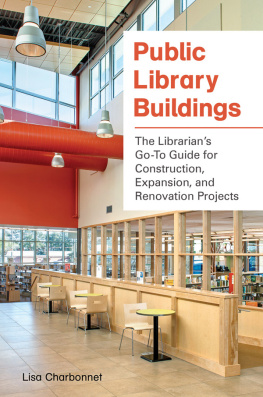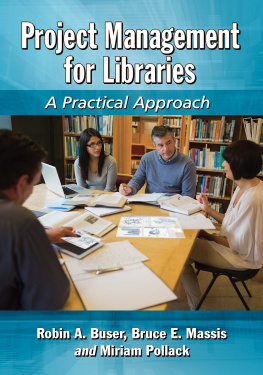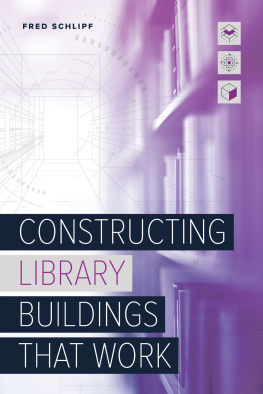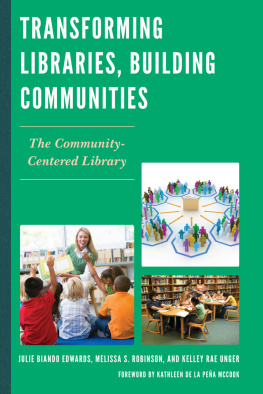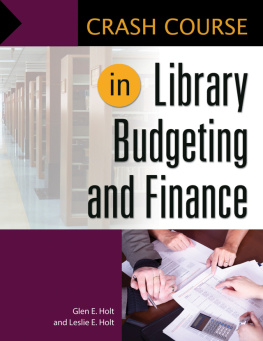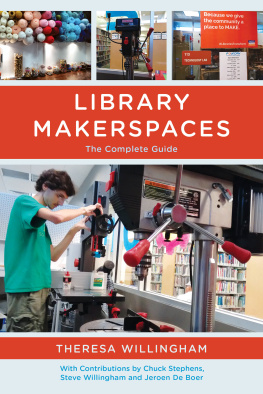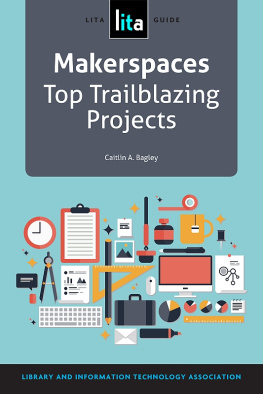Public Library Buildings
Public Library Buildings
The Librarians Go-To Guide for Construction, Expansion, and Renovation Projects
Lisa Charbonnet

Copyright 2015 by Lisa Charbonnet
All rights reserved. No part of this publication may be reproduced, stored in a retrieval system, or transmitted, in any form or by any means, electronic, mechanical, photocopying, recording, or otherwise, except for the inclusion of brief quotations in a review, without prior permission in writing from the publisher.
Library of Congress Cataloging-in-Publication Data
Charbonnet, Lisa.
Public library buildings : the librarians go-to guide for construction, expansion, and renovation projects / Lisa Charbonnet.
pages cm
Includes bibliographical references and index.
ISBN 978-1-4408-3858-3 (paperback) ISBN 978-1-4408-3859-0 (ebook)1.Library buildingsUnited StatesDesign and construction.2.Library buildingsRemodelingUnited States.3.Public librariesUnited StatesPlanning.I.Title.
Z679.2.U54C48 2015
022'.3140973dc232015022150
ISBN: 978-1-4408-3858-3
EISBN: 978-1-4408-3859-0
191817161512345
This book is also available on the World Wide Web as an e-Book.
Visit www.abc-clio.com for details.
Libraries Unlimited
An Imprint of ABC-CLIO, LLC
ABC-CLIO, LLC
130 Cremona Drive, P.O. Box 1911
Santa Barbara, California 93116-1911
This book is printed on acid-free paper 
Manufactured in the United States of America
For Clark, always, always, always
Contents
I am grateful to have had the benefit of the expertise, eagle-eyes, and goodwill of my three readers, Beth Fox, the retired director of the Westbank Libraries in Austin, Texas; Barry Sturrock, principal architect of Piwonka-Sturrock Architects in San Antonio, Texas; and Scott Swiderski, PE, of H.R. Gray, a construction management company. They have offered excellent insights, additions, and a helping hand as I stumbled through the fog, trying to clarify some of these complex concepts. Of course any remaining mistakes are absolutely mine.
I have also been so very fortunate to have librarians from all over the country, weigh in on the ups and downs of their library construction experiences. These wonderful people have been in the trenches and have taken the time to add their voices to this conversation about building public libraries. I am happily indebted to Becky Baker, Lois Bannister, Karen Ellis, Morgan McMillian, Daniel Schwartz, Gail Sheldon, Joyce Trent, and Betty Yarborough.
Ive had the good luck to work on two recent library construction projects, the Laura Bush Community Library of Austin, Texas, and the renovation and expansion of the Pflugerville Public Library in Pflugerville, Texas. These are two beautiful libraries brought into existence by teams of dedicated, inspired, and committed people, including but not limited to construction companies and crews from Lee Lewis and Zapalac-Reed, architects Piwonka-Sturrock and Studio 8, project managers and owners representatives Scott Swiderski and Jeff Musgrove, Library Board members and city officials, the Friends of the Libraries, and literally hundreds of volunteers. Let me extend a special thank you to my friends and colleagues, the marvelously resilient and consistently creative staff of both libraries. Id also like to recognize the helping hands and thoughtful suggestions of my wonderful editor, Barbara Ittner, and the team at ABC-Clio, particularly production editor Nicole Azze.
The outpouring of love and support from my family has been immense and so much appreciated.
Thank you all more than I can say!
So, theres a library building project in your future!
You feel pulled in lots of ways, excited about the possibilities, anxious to get it right, wondering about the budget, the team, and the time it will take. Some people will tell you to think like an architect, and others will start in on paint colors and furniture. You dont need to think like an architect, your architect does. You need to think like a librarian and your input is essential.
Public libraries are enormously diverse. They represent the full mosaic of American communities. Accordingly, no one can prescribe exactly what each public library building should look like. To further complicate the issue, public library construction projects can happen at wide intervals of both time and space. Few professionals, including architects, contractors, and city officials, have experience with a librarys unique and complex requirements.
Before we began the process of finding a new location for our library, I took some on-line university short classes on library design, etc. Plus, I read professional magazines, toured other libraries, and talked to librarians. I learned a lot, but, of course, I learned more by experience.
Lois Bannister
Director, Garland Smith Public Library
Marlow, Oklahoma
This book is addressed to you, the librarian, whatever is your title and however big is your library or its project. Its object is not to tell you how to build your library, but to lead you in a series of questions that will help you identify your needs and translate them effectively to stakeholders, funders, and the construction team.
It will bring up topics, in sequence, you will need to consider for a successful building project. If your project is relatively small and well-funded, you will be able to skip some chapters; if youre undertaking a complex renovation and expansion, youll need everything. Each chapter contains tips and tricks for you to accept or reject. The chapters are peppered with examples of issues faced by other librarians.
The best use of this book is to become interactive with it. Scribble in the margins, stuff it in a pocket or on an iPad, talk back to it, pass the checklists around, and answer the questions in your own way.
Library construction is an iterative process, full of team meetings, discussions, and compromises with a wide range of participants. It is exciting, frustrating, and generative. Start in with flexibility and good humor and remember the goal is to provide everyone with a better, more efficient, more comfortable library.
Go ahead! You have permission to dream: room for seating areas, lots of natural light, a complete technology upgrade, lower shelving and plenty of it, plumbing that works, space in the parking lot, a childrens area, a teen room, a good roof, new carpet or even rubber flooring. Close your eyes and imagine how fantastic your library could be.
This is the stage for rosy pictures without constraints. This is the one stage where it costs you nothing, so let your imagination soarfrom the prosaic to your fondest fantasies.
Doodle while you dream. Start small or start big, mix it all up on the back of an envelope or a scratch pad, this is for you. Take as long as you like, revisit it often; throw it all in a file for reference.
Now open your eyes.
- Vision is developing a deep understanding of what your library is and where it can go to best serve the patrons of your community.
- Vision is a developed skill, one you can learn.
- Vision is the underpinning of every successful building project.

